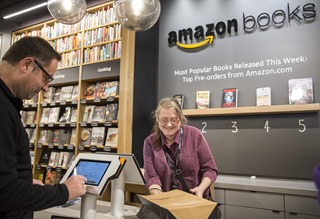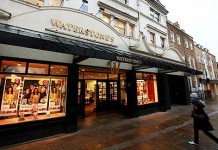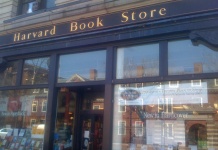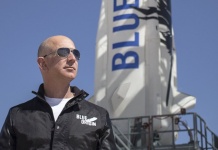 I already mentioned, a few days ago, that Amazon job postings suggested it was planning to open an Amazon Books retail outlet in the San Diego or La Jolla area. But now the San Diego Union-Tribune has taken notice, and posted a feature article looking at the prospect and how local booksellers felt about it.
I already mentioned, a few days ago, that Amazon job postings suggested it was planning to open an Amazon Books retail outlet in the San Diego or La Jolla area. But now the San Diego Union-Tribune has taken notice, and posted a feature article looking at the prospect and how local booksellers felt about it.
I’m not entirely thrilled with the quality of the journalism involved. For example, there’s this paragraph, taken verbatim from the story at the time I was reading it (they’ve since corrected it after one of their commenters also pointed it out):
The singular bookstore, which sells a limited selection of the site’s most popular and best-reviewed titles, doubles as a showroom for Amazon gadgets, including its Nook, Fire TV, Fire tablets and Echo, the always-on speaker that can handle a variety of voice-based commands.
Can you spot the thing that made me laugh out loud when I read it? This, in a major Gothic-font-hyphenated-name newspaper from a major metropolitan market? (And that’s not even getting into whether they called the bookstore “singular” but actually meant to say “single.” I suppose you could make a case for that either way.)
Shoddy fact-checking aside, the article seems to be a veritable smorgasbord of the sentiment that some have termed “Amazon Derangement Syndrome.” It quotes John Mutter of Shelf Awareness calling Amazon Books’s selection “kind of skimpy.” It mentions the ABA’s “Amazon and Empty Storefronts” report about how much retail space Amazon is allegedly blighting. After touching on all the San Diego area bookstores that have closed in recent years, it quotes one of the owners of the Mysterious Galaxy bookstore referring to Amazon’s “predatory business model,” and saying “They operate in the Walmart mode where they don’t add any value to any community they move into.”
That’s a bit of a funny line, given that if you asked the average consumer how they felt about both the Amazon Books store and Wal-Mart, they’d probably have some different ideas. Amazon Books wouldn’t have any customers if they didn’t feel it “added value” for them—as this writer on Vox found when he entered skeptical and walked out a convert. And let’s not forget all the other programs Amazon offers, such as Amazon Prime Now same-day delivery of a selection of products, in such communities. A number of consumers find that having such programs available “adds value” to their lives, myself included. As for Wal-Mart, while it might be bad news for local business owners, a lot of local consumers are happy to have such an outlet in their area.
When Wal-Mart recently closed a number of underperforming stores, my parents expressed dismay that Wal-Mart was leaving some of the smaller townships near them. For those townships, the closing Wal-Mart had been the only store for miles. I expect their residents would be happy to differ with that bookstore owner on exactly how much “value” those stores had brought to their community by opening up there, and taken back away by closing again.
But back to ADS. One of the staff of La Jolla bookstore Warwicks thinks Amazon might be planning to try to go after meet-the-author events, one of the only big areas where local bookstores can offer something Amazon can’t. Shelf Awareness’s John Mutter suggests such events are one of the main reasons for the recent resurgence of bookstores, and concludes, “In the book world, Amazon is an evil empire.” Predatory business model, evil empire…doesn’t this article have some great scare quotes? And for all that, it didn’t even bother to get the brand name of Amazon’s e-book reader right!
The article does close with viewpoints from a local bookstore owner and one of the co-founders of Portland-based Powell’s, neither of whom is concerned—but it doesn’t really go much into their reasoning, so after spending most of an article talking about how eeeeeevil Amazon is, it comes off as a sort of desultory pro-forma attempt to cover the opposing viewpoint.
I personally wonder whether the more important aspect of the store is not so much the book selection as it is the Kindle showroom section. Amazon hasn’t really had one of those, given that it hasn’t had local storefronts. Indeed, it’s had “competitors” like Wal-Mart downright stop carrying the Kindle. And remember that, in early days, Amazon marketed the Kindle via the “See a Kindle in Your City” program, by putting local Kindle owners and enthusiasts in touch with potential buyers in their area, so they could get their hands on one in person to see how it worked. Apparently being able to see e-ink devices in person does help drive their sales.
Of course, that’s not such a big deal now that the market for e-ink readers is declining and tablets are getting so much better. But being able to demonstrate Fire tablets in person, especially the $50 model, could be an even more compelling case for local showrooms. After all, it stands to reason people could be suspicious of devices that are so cheap—until they get the chance to try them out. And once someone has a Fire, they’re going to buy more stuff from Amazon whether they come into the retail store or not.
Of course, having a Nook showroom in every store hasn’t exactly done much for Barnes & Noble, but B&N hasn’t exactly been the most on the ball at managing its retail and e-tail businesses in any event. And whatever you think about Amazon, it wouldn’t have been nearly as disruptive to the existing establishment if it hadn’t been so devastatingly well-managed.
In any event, it’s interesting to see Amazon’s retail plans proceed apace, and continue to scare nearly everyone in the traditional establishment who notices them. I look forward to finding out what happens next.

































Wait, did the article really slip up and refer to the Amazon Nook? You’re playing a joke on us, right?
It did. I suppose I should probably have screen-capped it as proof, as they’ve fixed it now, but you can still see in the comments below it where someone points out the matter.
I’m still having trouble believing it. (not that I doubt you)
[…] The San Diego Union-Tribune reported on this story yesterday in an article rife with ant-Amazon propaganda, hostility, and errors (an early version of the piece referred to the Amazon Nook – no joke). […]